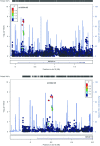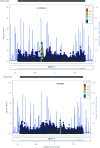Generalised Anxiety Disorder--A Twin Study of Genetic Architecture, Genome-Wide Association and Differential Gene Expression
- PMID: 26274327
- PMCID: PMC4537268
- DOI: 10.1371/journal.pone.0134865
Generalised Anxiety Disorder--A Twin Study of Genetic Architecture, Genome-Wide Association and Differential Gene Expression
Abstract
Generalised Anxiety Disorder (GAD) is a common anxiety-related diagnosis, affecting approximately 5% of the adult population. One characteristic of GAD is a high degree of anxiety sensitivity (AS), a personality trait which describes the fear of arousal-related sensations. Here we present a genome-wide association study of AS using a cohort of 730 MZ and DZ female twins. The GWAS showed a significant association for a variant within the RBFOX1 gene. A heritability analysis of the same cohort also confirmed a significant genetic component with h2 of 0.42. Additionally, a subset of the cohort (25 MZ twins discordant for AS) was studied for evidence of differential expression using RNA-seq data. Significant differential expression of two exons with the ITM2B gene within the discordant MZ subset was observed, a finding that was replicated in an independent cohort. While previous research has shown that anxiety has a high comorbidity with a variety of psychiatric and neurodegenerative disorders, our analysis suggests a novel etiology specific to AS.
Conflict of interest statement
Figures







References
-
- Wittchen HU (2002) Generalized anxiety disorder: prevalence, burden, and cost to society. Depress Anxiety 16: 162–171. - PubMed
-
- Tyrer P, Baldwin D (2006) Generalised anxiety disorder. Lancet 368: 2156–2166. - PubMed
-
- Simon NM (2009) Generalized anxiety disorder and psychiatric comorbidities such as depression, bipolar disorder, and substance abuse. J Clin Psychiatry 70 Suppl 2: 10–14. - PubMed
-
- Paris J (2013) Making the DSM-5: concepts and controversies New York: Springer.
Publication types
MeSH terms
Substances
Grants and funding
LinkOut - more resources
Full Text Sources
Other Literature Sources
Medical
Research Materials
Miscellaneous

